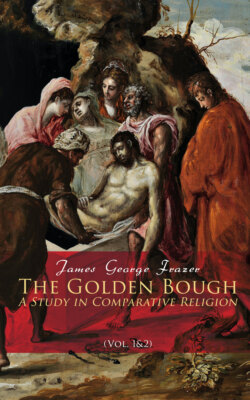The Golden Bough: A Study in Comparative Religion (Vol. 1&2)

Реклама. ООО «ЛитРес», ИНН: 7719571260.
Оглавление
James George Frazer. The Golden Bough: A Study in Comparative Religion (Vol. 1&2)
The Golden Bough: A Study in Comparative Religion (Vol. 1&2)
Table of Contents
Volume 1
Chapter I. The King Of The Wood
§ 1.—The Arician Grove
§ 2.—Primitive man and the supernatural
§ 3.—Incarnate gods
§ 4.—Tree-worship
§ 5.—Tree-worship in antiquity
Chapter II. The Perils Of The Soul
§ 1.—Royal and priestly taboos
§ 2.—The nature of the soul
§ 3.—Royal and priestly taboos (continued)
Chapter III. Killing The God
§ 1.—Killing the divine king
§ 2.—Killing the tree-spirit
§ 3.—Carrying out Death
§ 4.—Adonis
§ 5.—Attis
§ 6.—Osiris
§ 7.—Dionysus
§ 8.—Demeter and Proserpine
§ 9.—Lityerses
Footnotes
Volume 2
Chapter III—(continued)
§ 10.—The corn-spirit as an animal
§ 11.—Eating the god
§ 12.—Killing the divine animal
§ 13.—Transference of evil
§ 14.—Expulsion of evils,
§ 15.—Scapegoats
§ 16.—Killing the god in Mexico
Chapter IV—The Golden Bough
§ 1.—Between heaven and earth
§ 2.—Balder
§ 3.—The external soul in folk-tales
§ 4.—The external soul in folk-custom
§ 5.—Conclusion
Note. Offerings of first-fruits
Footnotes
Отрывок из книги
James George Frazer
Complete Edition
.....
Again, tree-spirits make the crops to grow. Amongst the Mundaris every village has its sacred grove, and “the grove deities are held responsible for the crops, and are especially honoured at all the great agricultural festivals.”253 The negroes of the Gold Coast are in the habit of sacrificing at the foot of certain tall trees, and they think that if one of these trees were felled, all the fruits of the earth would perish.254 Swedish peasants stick a leafy branch in each furrow of their corn-fields, believing that this will ensure an abundant crop.255 The same idea comes out in the German and French custom of the Harvest-May. This is a large branch or a whole tree, which is decked with ears of corn, brought home on the last waggon from the harvest-field, and fastened on the roof of the farmhouse or of the barn, where it remains for a year. Mannhardt has proved that this branch or tree embodies the tree-spirit conceived as the spirit of vegetation in general, whose vivifying and fructifying influence is thus brought to bear upon the corn in particular. Hence in Swabia the Harvest-May is fastened amongst the last stalks of corn left standing on the field; in other places it is planted on the cornfield and the last sheaf cut is fastened to its trunk.256 The Harvest-May of Germany has its counterpart in the eiresione of ancient Greece.257 The eiresione was a branch of olive or laurel, bound about with ribbons and hung with a variety of fruits. This branch was carried in procession at a harvest festival and was fastened over the door of the house, where it remained for a year. The object of preserving the Harvest-May or the eiresione for a year is that the life-giving virtue of the bough may foster the growth of the crops throughout the year. By the end of the year the virtue of the bough is supposed to be exhausted and it is replaced by a new one. Following a similar train of thought some of the Dyaks of Sarawak are careful at the rice harvest to take up the roots of a certain bulbous plant, which bears a beautiful crown of white and fragrant flowers. These roots are preserved with the rice in the granary and are planted again with the seed-rice in the following season; for the Dyaks say that the rice will not grow unless a plant of this sort be in the field.258
Customs like that of the Harvest-May appear to exist in India and Africa. At a harvest festival of the Lhoosai of S. E. India the chief goes with his people into the forest and fells a large tree, which is then carried into the village and set up in the midst. Sacrifice is offered, and spirits and rice are poured over the tree. The ceremony closes with a feast and a dance, at which the unmarried men and girls are the only performers.259 Among the Bechuanas the hack-thorn is very sacred, and it would be a serious offence to cut a bough from it and carry it into the village during the rainy season. But when the corn is ripe in the ear the people go with axes, and each man brings home a branch of the sacred hack-thorn, with which they repair the village cattle-yard.260 Many tribes of S. E. Africa will not cut down timber while the corn is green, fearing that if they did so, the crops would be destroyed by blight, hail, or early frost.261
.....